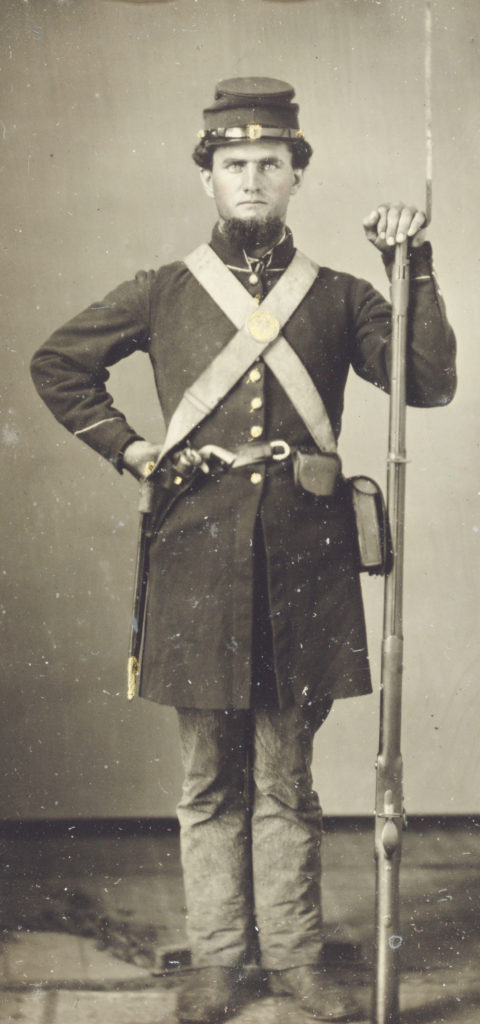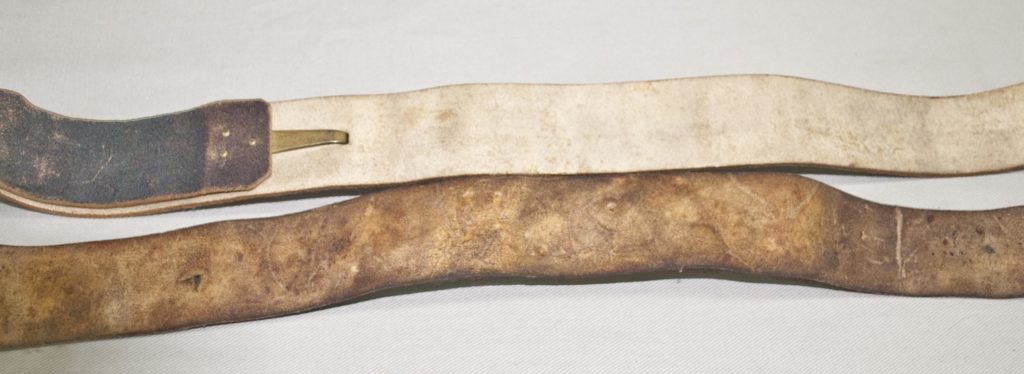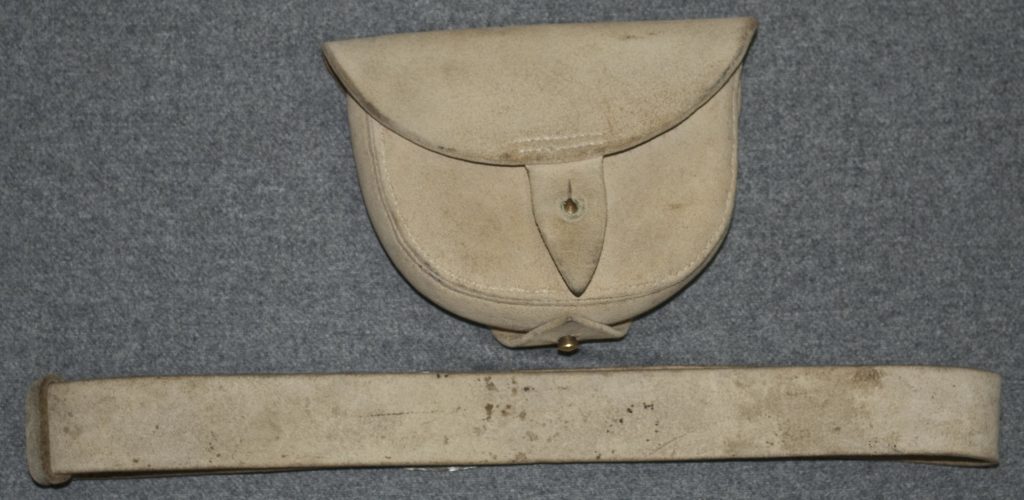THE STRANGE HISTORY OF BUFF LEATHER- ITS ORIGINS AND MILITARY APPLICATIONS
By David Jarnagin & Ken R Knopp
Published in several periodicals, this article was the Journal of Military Collector’s and Historian winner of the William K Emerson Writing Award for the best article of 2016.
“Buff” leather? While most military historians believe that they know what the term means, the reality is that this leather is one of the most misunderstood leather types from the 19th century, particularly here in America. The name itself conjures up all kinds of thoughts and questions about what “buff” is and where it comes from. The confusion about buff actually goes back centuries. It begins with its name but is further complicated by its unique surface texture, often referred to as “rough out” or “fuzzy”. Much of the confusion stems from 18th century writings, which erroneously surmised from the name that it was tanned from the shaggy buffalo. Some have even gone so far as to suggest it was tanned from water buffalo. 1. Neither is true. So, where did the name come from and, what was the original animal hide the leather was tanned from? How was this leather made? More importantly, what are its military applications and why is there white, black and brown buff?
Buff leather acquired its original name from a very obscure source. The very first buff leather came from the hide of the ancient Urus (or Aurochs), an early type of wild cattle that centuries ago roamed Europe, Asia and North Africa. Commonly known as the “Buffe” this now extinct bovine, was a large, stout animal that stood up to 6.5 feet tall at the shoulder and weighed 2200 pounds. The very first recorded military use of buff leather was in the early 1500’s when English King Henry VIII imported a number of “buffe-hides,” which were tanned and manufactured into leather for military clothing. This “buff-leather” was very thick, durable yet supple and known to be so strong it would turn the edge of a sword and was impervious to the pistol ball of the period. However, its use was short lived. The last of the Urus/Aurochs breed died in the early 1600’s. It was only then that domestic cattle began to be routinely used for making military leather. However, according to period writings they were found to be inferior in quality to the Uros. 2. The innate confusion of buff leather was further perpetuated by the common practice of referring to any breed of wild oxen as a “buffalo”. Which of course may explain why our American bison was mis-labeled a “buffalo”.
To really understand the nature of buff leather, one must first understand leather tanning – the process by which raw animal hides are finished into useable leather. Good quality bridle and harness leather requires tanners start with hides of only the best, smooth, unblemished surfaces then apply a process that strengthens and preserves yet leaves the grain surface even in texture and color. For thousands of years tanning has employed an intricate, laborious, multi-step, natural chemical process to make differing animal hides into various weights, thicknesses, colors and grades of leather for a myriad of human uses and applications. For most of that time, the more well known “vegetable” or bark tanning method was commonly achieved by repeat soakings of the raw hide first in lime, then solutions made from the bark of trees which generates an acidic chemical reaction that slowly turns the hides into leather. The “tannin” (tanning agents) found in the bark is the central ingredient that preserves the hide- first by stopping natural decay then leaving the leather both flexible yet durable enough for extended use. Most leathers were hand finished with various stains, tallows and other compounds to give them a durability and a smooth, even texture and color. Another popular tanning method in the period was “mineral tanning” which encompassed all other non-vegetable methods for preserving hides into leather. 3.
Tanning buff leather was unique. Since a smooth surface is not the objective with buff leather, tanners started with only the poorest quality or damaged hides for finishing into buff’s rough facing. Tanners heavily limed or sanded the hide which stripped the smooth grain surface to a fine suede. They then employed alternating combinations of alum and salt tanning (a form of mineral tanning called Tawing). For white buff the tanning process ended there and whiteners were added to finish the leather. Buff that was to be ultimately dyed black was oak stained and then sealed with a protective cod oil surface tan which left the leather a yellowish-brown chamois color. Unfortunately, the oil tanning process requires a specific range of temperatures that must be performed in direct sunlight thus limiting its tanning to short periods in the spring and fall. Regardless of the final color buff tanning was tedious, labor intensive and expensive. Perhaps more important, it had a very limited market outside of military contracts. As a result, few tanners were willing to devote the necessary resources to its production and the few that did so, of course, charged high prices. Nevertheless, it was this unique process that produced buff’s distinctive fuzzy, rough out surface and also gives it the durability, look and feel that differentiates it from all other leathers. 4.
Over the next three centuries tanners refined their abilities to produce a buff leather that nearly replicated the strength and durability of the Urus hides, but made from domestic cowhide. Throughout this period, European and later, American military applications for buff was primarily in making accoutrement belts and clothing. Period writing describe the original buff leather as generally a light yellow color. 5. This yellow-creme color would remain synonymous with buff leather until the late 1700’s when the European and American armies began to add whiteners to give it a distinctly uniform white color. The source of these whiteners was “Paris Whitening” which is simply powdered chalk that was worked in at the finishing end of the tanning process. Unfortunately, white buff gets soiled quite quickly which necessitated that soldiers be issued pipe clay and whiteners to keep up the appearance of the buff leather. 6.
By the early 1800’s enough time had passed that both the Europeans and Americans referred to buff leather simply as “buff”meaning its white (or sometimes white-yellow) color of the leather and no longer the ancient animal or even the tanning process. 7. In the American army, white buff was used for infantry and cavalry accoutremments including waist belts, cartridge box slings and carbine slings. This leather color remained the dominant choice for the U. S. Army until the early 1850’s. By then, the plentiful supplies remaining from the recent Mexican War were running low and due to the complexity of the buff tanning processes tanneries charged high prices for new buff leather. Moreover, the high maintenance of white buff (and its restoration remedies) soiled the appearance of the dark blue military uniforms. Because of all of this the army began changing its leather orders over to blackened buff and increasingly, “waxed” black leather belts. 8.
However, when the army switched to the other black leathers it was not without some controversy. First, field troops were resistant to change preferring white buff as cleaner, more durable and more “dashing”. Apparently the oil in the new black buff also came off when wet soiling clothing but, more appalling in the summer it drew flies! According to one officer, attracting “such a swarm of them, as to become disgusting to the sight, nauseating to the stomach, and in fact absolutely tormenting to the soldier.” 9.
Another problem for the Ordnance Department was the changeover itself. As they quickly
found out, white buff cannot be re-dyed. As a result, all the leather in arsenal inventories and in the field had to be sent back to the tanneries to have the whiteners removed and then oak stained to allow the leather to be dyed black. By the Civil War, white buff accoutrements had been entirely replaced by black buff, or more common “waxed” leather in the regular army however, some could still be found among militia units. 10. The war revived buff leather tanning to the extent great quantities were again being made and issued until mid war when more easily and less expensive bridle and waxed leathers significantly dominated manufacture. Where does brown buff leather come in? Today’s brown buff military artifacts are simply black buff accoutrements that have faded back to their original brown stain. This fading occurs because the logwood in the black stain cannot hold the iron mordants over extended periods of time which causes the eventual reversion back to the brown stain color.
Today, original, pre-civil war “white buff” American military accoutrements are rare. Other than the obvious scarcity afforded all old military artifacts, another reason they are so rare is the fact that many of the military belts were used in the 19th century for other purposes. Some were employed as knife or razor sharpening straps but many more were cut up as tools for polishing brass. 11. The common name for these polishing tools was “buff sticks”. These were wooden sticks with pieces of buff leather wrapped then glued or nailed to the end of the stick. Grit made of Crocus and rotten-stone was used as a polishing agent with the buff sticks since the porous nature of the buff leather allowed the grit to be held in place. Buff sticks were routinely issued to the troops in the 19th century British and American armies to polish their brass but they were also commonly used by jewelers and other trades for polishing. 12.
The myths and mysteries of buff leather originated centuries ago and have ever since remained stubbornly persistent across many continents and cultures. Perhaps now the facts can help historians understand the true nature and contributions of this long mis-understood but important part of our military culture.
-30-
About the authors: David Jarnagin is co owner of C & D Jarnagin the nation’s largest manufacturers of 18th and 19th century military reenactment clothing and equipment. For over twenty years David’s domain has been the company leather shop where they make authentic cartridge boxes, cap boxes, belts, bayonet scabbards, knapsacks, shoes, boots and more. A passion for the study and experimentation with period leather tanning, dyeing, preservatives, equipment manufacture and of course, the handling of thousands of artifacts have made David uniquely qualified in the subject of 19th century leather processes, footwear and leather equipment.
Ken R Knopp, is a Financial Advisor with Edward Jones Investments and the author of three books, “American Riding Saddles (and Horse Culture) 1790- 1920”; “Confederate Saddles & Horse Equipment” and “Made in the CSA, Saddle Makers of the Confederacy”, as well as numerous articles about 19th century saddlery, leather and Confederate accoutrements. See www.confederatesaddles.com
FOOTNOTES:
- Buff: (Webster’s 1828 dictionary) [contracted from buffalo,or buffskin.] Buffskin; a sort of leather, prepared from the skin of the buffalo, dressed with oil, like shammy. It is used for making bandoliers, belts, pouches, gloves and other articles. The skins of oxen, elks and other animals, dressed in like manner, are also called buffs.
Buffalo: (Webster’’s 1828 dictionary) [L. bubalus.] The Bubalus, a species of the bovine genus, originally from India, but now found in most of the warmer countries of the Eastern Continent. It is larger and less docile than the common ox, and is fond of marshy places and rivers. The name is also applied to wild oxen in general, and particularly to the Bison of North America.
- Transactions of the Society instituted at London for the Encouragement of Arts, Manufactures and Commerce: with Premiums Offered for the Years 1833-34 and 1834-35, Vol. L, London, 1836, pg. 194.
- David Jarnagin and Ken R. Knopp, SECRETS OF THE 19th CENTURY LEATHER TANNERY. Journal of the Military Collector & Historian, The Company of Military Historians, Washington DC., Vol. 61, No. 1 — Spring 2009
- Encyclopedia Britannica; or, a Dictionary of Arts and Sciences, Compiled Upon a New Plan, Vol. III, by A Society of Gentlemen, in Scotland, A. Bell and C. Macfarquhar, Edinburgh, Scotland, 1771 pg. 889 (This is really an Alum and sea salt tannage. This is the oldest form of tanning known to man. This tannage gives the leather the body needed to work in military applications. The oil tannage on its own would give you chamois leather, which does not have the body or strength for military applications. ) The American Leather Chemist Association defines tawing: The old English term applied to the process of making leather with alum as distinguished from tanning, which was originally confined to vegetable tanning. (http://www.leatherchemists.org/dictionary.asp)
- The color of buff; a light yellow. Transactions of the Society instituted at London for the Encouragement of Arts, Manufactures and Commerce: with Premiums Offered for the Years 1833-34 and 1834-35, Vol. L, London, 1836, pg. 194
- Privates Solder’’s and Militia Man’’s Friend, by Henry Trenchard, Serjeant Major, G. Kearsley, 1786, pg. 27
The Political State of The British Empire, Vol. II, by John Adolphus, Esq., T. Cadell and W. Davies, in the Strand, London, 1818, pg. 313
- A Military Essay. Containing Reflections on the Raising, Arming, Cloathing, and Discipline of the British Infantry and Cavalry, by Campbell Dalrymple, Esq; Lieutenant Colonel to the King’’s own Dragoons., D. Wilson, at Plato’’s Head, in the Strand, London, 1761, pg. 42.
- Craig to Ramsay, St Louis Arsenal, July 25, 1855, National Archives Record Group 156, Entry 6 Vol. 15, pg. 319
- Capt. Shepard, Co. B, 3rd Infantry, Fort Defiance, NM, to Craig, March 21, 1855, National Archives Record Group 156, Entry 21 Box 149/S-209.
- David Jarnagin and Ken R. Knopp, SECRETS OF THE 19th CENTURY LEATHER TANNERY. Journal of the Military Collector & Historian, The Company of Military Historians, Washington DC., Vol. 61, No. 1 — Spring 2009
- The Gentleman’’s Magazine and Historical Chronicle For the Year MDCCCII Volume LXXII Part the First. by Sylvanus Urban, Nichols and Son, London, 1802, pg. 217
- The Technical Repository: Containing Practical Information on Subjects Connected with Discoveries and Improvements in the Useful Arts, Vol. II, by Thomas Gill, T. Cadell, Strand, London, 1822, pg. 207
The Royal Military Panorama, or Officers’’’’ Companion, Vol. IV., C.J. Barrington, Strand, Corner of Catherine Street, London, 1814, pg. 365 Here were a couple of others way buff leather was used for polishing. Buff leather is used in various ways for polishing; thus it is glued on the circular edges of plane surfaces of wooden polishing wheels, and used with coarse emery, crocus, rottenstone, and other powders.
Buff Sticks are parallel rods of deal upon which strips of buff leather are fixed, either by means of glue, of by folding the leather around ends, and securing it by iron tacks. The buff sticks are principally used with crocus and rottenstone, either with or without oil, and for most of the metals as well as various other substances; in some few cases the buff stick is moistened with water.
Turning and Mechanical Manipulation, by Charles Holtzapffel, published by Holtzapffel and Co., London, 1864, pg. 1042
PHOTOS:
 |
PHOTO # 1: Despite being “posed” this studio photo clearly shows how dirty whitened buff accoutrements can become from field use. LOC Collection
PHOTO # 2: Pictured are three types of leather used in U.S. military waist belts. The top is white buff, middle is blackened buff and the bottom is waxed leather. Author’s collection.

PHOTO # 3: This photo shows the underside of two different blackened buff belts. The lower belt is not well tanned whereas the top one shows what the inside of a blackened buff belt should look like when tanned properly. Note the area behind the hook on the top belt where its original black color is still present. The edges were always dyed on buff leather belts. Author’s collection
 |
PHOTO #4: All buff leather required constant upkeep. This faded blackend buff NCO belt shows the necessity of constant maintenance, which strongly motivated the army’s move to waxed leather accoutrements. Author’s collection
 |
PHOTO #5: Top: English pattern October 21, 1859 Ball Bag made from whitened buff. Bottom: U.S. Army pattern 1844 (whitened) buff waist belt. As can be seen there is very little difference between the buff leather made in England and that made in the US. Constant work was needed by the soldiers to keep the buff from looking dingy. Author’s collection
 |
.